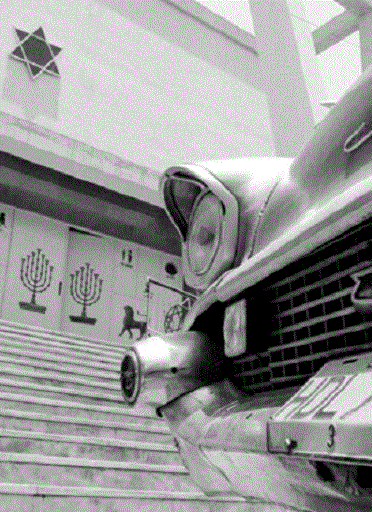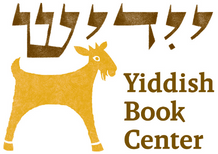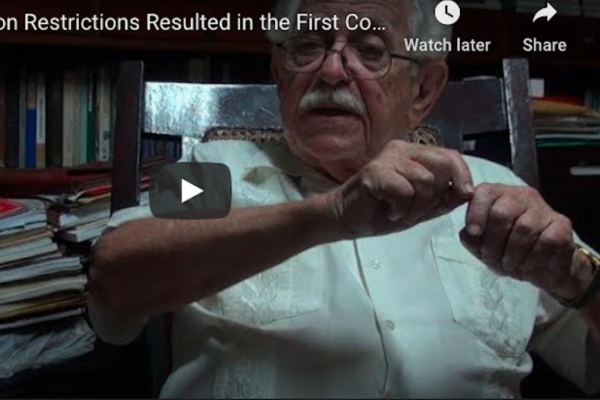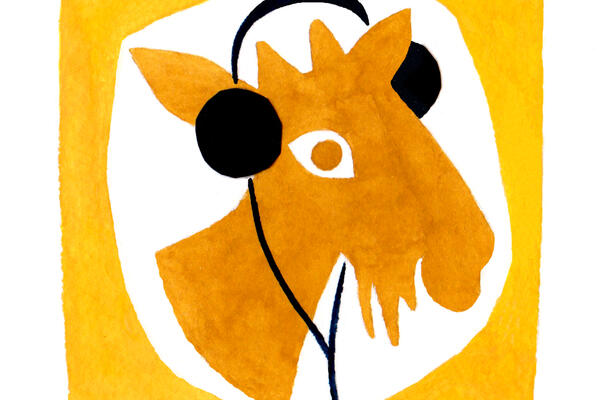
A Room Named Ruth
Searching for a Jewish Home in Cuba
- Written by:
- Ruth Behar
- Published:
- Fall 2007
- Part of issue number:
- 55

There are people who say they can remember way back, if not to the time when they were born, at least to the time they were two or three years old. But I am not so lucky. I was four and a half when I left Cuba with my family and I don’t have any memories of my native land.
Growing up in New York, I was always grateful that my parents managed to salvage so many family photographs in the midst of our hurried departure in the early 1960s. Looking at the photographs of my Jewish family in Cuba, I imagined that if I stared at them long enough, I would remember something of my lost childhood.
The black-and-white photographs had traveled unharmed from the island to the various gloomy apartments we came to occupy on the edge of New York City. Hardly a rip or a scratch marred their surface of light and shadow; they looked as pristine as the day they were taken. As the years passed and it became obvious we wouldn’t be returning to live in Cuba, and as we realized, more hopelessly, that perhaps we would never more set eyes on the beloved island, those photographs became precious to us—they were all we had left of Cuba.
Until I returned to the island to see it with my own eyes, briefly in 1979 and then on a series of visits that began in 1991, I wondered if the time my family had spent in Cuba was true or a dream, a sublime illusion. But the photographs in which I appeared in Cuba—playing on our old balcony, walking to the park with my grandparents, or dressed in a school uniform in front of the bus that took me to my preschool at the Centro Israelita—offered proof that the island remembered me, even if I didn’t remember it.
Since the time of Columbus’s first voyage, Jewish “conversos” were present in Cuba. “Conversos” were Jews who had converted to Catholicism rather than choose expulsion from Spain in 1492. They were viewed with suspicion, because many were secret Jews who wore a Catholic mask to ward off persecution by the Inquisition. Luis de Torres, a Jewish “converso,” traveled with Columbus to Cuba as a translator—just in case any of the natives happened to speak Hebrew, Aramaic, or Arabic.
But the history of the Jews in Cuba—as openly practicing Jews—begins much later, when three distinct Jewish groups took form: American Jewish expatriates who settled in Cuba after the War of 1898, as Spanish colonial rule ended and American postcolonial domination took root; Sephardic Jews who arrived in Cuba from Turkey as early as 1904 and continued in greater numbers following the dissolution of the Ottoman Empire; and Ashkenazi Jews, largely from Poland, who came after the 1924 Immigration and Nationality Act, which imposed a quota on their immigration to the United States. Polish Jews settled in Cuba in such large numbers that Cubans assumed all Jews on the island came from Poland. The term “polaco,” or Pole, became interchangeable with the word “Jew.” It is the term still used in Cuba today to refer to a Jewish person, even someone of Sephardic background, or any native-born Cuban with Jewish ancestry.
The American Jews maintained American schools and hired English-speaking rabbis for their synagogue. In contrast, the Sephardic and Ashkenazi Jews from Europe came penniless. Initially many thought of Cuba as a transitory location, as “Hotel Cuba,” but when it became clear that the island wasn’t an easy stepping stone to reach the United States, they began to aspire to be Cuban and viewed Cuba as their promised land. In the early years these immigrants worked as peddlers. They took their wares not only to cities, but also to towns and villages and sugar mills in the countryside, establishing a Jewish presence even in remote corners of the island.
Over time, the immigrants prospered. By 1950, about 15 percent had become wealthy merchants who owned large stores and wholesale enterprises. But the majority ran small mom-and-pop shops in Old Havana and provincial cities and towns.
In a little more than three decades, the immigrants and their first-generation offspring created an impressive range of educational, social, and cultural institutions. They founded Jewish schools and Jewish newspapers, in which every ideological and religious position was represented—from Zionist to Communist. Five synagogues existed in Havana. The oldest was the Chevet Ahim, built by Sephar-dic Jews in 1914, on a street that couldn’t have been more ironically named: the Street of the Inquisitor. The larger part of the Jewish community was in Havana, but there were synagogues in Santa Clara, Camagüey, and Santiago de Cuba, and Jewish associations across the island.
In Havana, Jews were so convinced they’d landed in a safe haven, they expected to stay forever. In the mid- to late 1950s, on the eve of the Revolution, they publicly displayed their desire for a permanent place on Cuban soil by building three enormous new synagogues: Adath Israel, an Orthodox synagogue, the Patronato, a Jewish community center, and the Centro Sefaradí, a Sephardic temple, completed as members uttered their last goodbyes.
When the Revolution began in 1959, most of the Jews supported Fidel Castro. My mother said that she and my father, who’d married young and become parents to me and my brother in their early twenties, were thrilled to receive a reduction in their rent. But she also recalled that her Uncle Moisés, who owned real estate in Havana as well as a thriving machine supply store, wasn’t happy with the revolutionary reforms. He, like other Jews with a stake in capitalist ventures, kept a nervous eye on the changes, but hung on, hoping the reforms wouldn’t hit too close to his investments.
But by 1961, as more and more businesses, including mom-and-pop shops, were seized by government militia, their Jewish owners didn’t hesitate any longer—they took the first plane out, many on the very day they lost their stores. The dissolution of the Jewish community in Cuba was swift, intense, like a lit candle snuffed by the wind. Of the fifteen to twenty thousand Jews who’d been in Cuba, only about two thousand chose to remain: a tenth of the Jewish community.
Suddenly it was all over, the tropical paradise was no more. Everything had to be abandoned, the dead left in their graves, the Torahs left in their synagogues, the schools, and the stores, and the homes, and everything in them, forsaken.
Although I was only a child, I was part of the mass exodus of the Jews who left Cuba after the Revolution and settled in the United States. Many went to New York and New Jersey, but most of the community landed in Miami with the other Cuban exiles, where the tropical climate made them feel more at home. Living through an unexpectedly hurried double uprooting led Jewish Cubans to think of their time in Cuba as even more enchanted than it had been. Frozen prematurely in time, they had to remake their identity as “Jubans” living in both the Jewish and the Cuban diaspora in the United States. To console themselves for their lost island, they worked doubly hard, and many achieved a level of success and wealth that would have been impossible to attain even under the best conditions in Cuba.
Very few Jewish Cubans left family behind on the island. Most left through a pattern of chain migration. As a result, the predominant attitude was not to look back. The focus was on building new lives in the United States, on striving for the prosperity of the American dream. The Cuban chapter of our diasporic wandering was over.
If you looked back, like Lot’s wife, you might turn into a pillar of salt.
As I grew older, I sought an outlet for my nomadic longings in the field of cultural anthropology. At first I traveled to Spain and Mexico, but I always knew that I needed to go back to Cuba and see what had become of my lost Jewish home.
When I returned to the island in 1991, it was the beginning of the “special period,” a time of existential uncertainty, scarcity, and hunger. The collapse of the former Soviet Union left Cuba stranded. Soviet subsidies had supported a social welfare system that gave Cubans access to inexpensive rationed food, material goods, education, and health care. As this safety net unraveled, material conditions worsened. The Castro government started investing heavily in tourism. Luxurious tourist reserves were soon occupied by foreigners, but closed to Cubans on the island, who felt the sting of hypocrisy at how the Revolution’s leaders had contradicted their goal of building an equitable society.
The economic crisis brought on such a profound moral crisis that the government felt it had no choice but to allow God and the saints to return to Cuba. In 1991 the Cuban Communist Party decreed that Party members could have religious affiliations. A year later, it was written into the Cuban constitution that the state would be secular rather than atheist. Cubans were suddenly at liberty to mix and match Jesus Christ, Karl Marx, independence leader José Martí, and Fidel Castro into their spiritual pantheon.
The door to religious freedom swung open and increasing numbers of Cubans turned to Catholicism, Protestantism, Pentecostal faiths, Masonic rituals, Judaism, and the Afro-Cuban religions of Santería and palo monte (known as a form of ancestor worship). Religion offered Cubans another way of thinking about power and human destiny at a time of cognitive dissonance. They could carve out an alternative space to pursue new social networks and explore fresh ideas about faith and community that filled the void left by state rhetoric and policies.
To facilitate the flow of hard currency, in the summer of 1993 the U.S. dollar, the currency of the imperialist enemy, was declared a legal currency in Cuba, to exist side by side with the Cuban peso. New hotels sprang up in tourist resorts like Varadero, and Eusebio Leal Spengler, the official historian of the city, began the project of restoring Havana, a city so fascinatingly in ruins that it has continually been likened by outside observers to Pompeii.
With the return to Cuba of both the U.S. dollar and God, the island became safe again for Americans—and soon they were arriving in droves, the curators looking for art, Ry Cooder looking for Cuban music, the undergrads looking for revolutionary hipness, the grad students looking for dissertation topics.
American Jews also started to go to Cuba in record numbers, and the island is now a favorite site for Jewish American philanthropy. Numerous “mitzva projects” have been bestowed upon the Jews of Cuba, making it possible for members of the community to learn Hebrew and Jewish history, to undergo conversion to Judaism, to be circumcised, to celebrate bar and bat mitzvas and Jewish weddings, to travel on all-expense-paid group vacations to resort areas in Cuba, and to eat chicken dinners after Friday and Saturday Jewish services, which for many are the main substantive meals of the week.
Going to Cuba to see the Jews who remain there has be-come a touristic-anthropological-Jewish solidarity mission. Jews from around the world, but especially from the United States, want to know them, study them, photograph them, film them, interview them, help them, uplift them, share with them, dream with them, own a piece of their story, give them medicine, heal them. The very idea that Jews have survived under Communist rule in Cuba seems incredible, even miraculous.
What began for me as an intensely personal search for a lost Jewish home soon changed as I watched with admiration, but also some trepidation, as the island’s Jewish community was revitalized before my eyes through the charitable support of American Jews. I wasn’t alone in my quest to learn about Jewish life in Cuba. I became the anthropologist more than I wanted to be – for I was in the position of being “in the between.” I was the ultimate insider and the ultimate outsider.
Caught between the old family photographs that gave me my first glimpse of a lost Cuba I couldn’t remember and the anthropological obsession with seeing real people in real places, I came to feel that the best way to tell the story of the Jews of Cuba was through storytelling in words and pictures. In collaboration with the Havana-based photographer Humberto Mayol, I traveled all over Cuba searching for Jews, Humberto with his camera and I with my pen.
The Jews of Cuba, I discovered, represent Jews in extremis, Jewsin an outpost of civilization, Jews who should have perished but didn’t, Jews flourishing in the last of the Communist lands, Jews who still breathe the revolutionary air of Che Guevara.
These Jews on the island have little in common with the immigrant Jewish Cuban community in the United States. Jews in Cuba are largely converts, Jews by choice. Most have converted because they are Jewish on their paternal rather than maternal side (being born from a Jewish womb is a traditional requirement for being a Jew) or because they have married a person of Jewish descent. They are mixed racially and a great deal poorer than Jewish Cubans in the United States. Like all Cubans on the island, they have limited access to information, few opportunities to travel, and little hope of economic mobility.
And yet, even with scarce resources, the responsibility of the Jews who remain in Cuba is to guard the Jewish legacy and keep it from disappearing.
It is the Jews on the island today who chant from the Torahs brought eighty years ago from Poland and Turkey.
Upon them has fallen the burden of preserving the scattered bits and pieces of Jewish life, the archaeological relics that have survived: wine cups, mezuzahs, a ketubah, family photographs, a tattered shirt from Auschwitz.
I learn that Jews in Cuba carry with them their old photographs and passports, letters, and postcards, as if at any moment they might be asked to prove their Jewishness.
On my first visits to Cuba in the early 1990s, I’d huddle on the Sabbath in the Patronato with a handful of other congregants as pigeons flew in and out of the torn roof. By 2002, Hollywood director Steven Spielberg had visited the Jews of Cuba. While in Havana for a film festival, he asked to be shown the Jewish cemetery and the Patronato, by then newly renovated with support from the Jewish Cuban community in Miami and complete with air conditioning, a computer room, and a video screening room. It was an emotional visit for Spielberg, and before leaving he thanked the Jews of Cuba for their labor of cultural preservation.
From pigeons in the synagogue to Spielberg in the synagogue—that defines the dramatic arc of transformations I have witnessed as a traveler to Jewish Cuba.
Maybe irony must inevitably accompany any nostalgic search for home. I found more irony than I could have imagined at the Hotel Raquel, which opened its doors for business in May 2003. Located in the heart of the Spanish colonial center in Old Havana, near the cathedral, the hotel is aptly situated on Calle Amargura—Bitterness Street.
This is a prime real estate area in the emerging Cuba of the twenty-first century. Old Havana has been slated for tourist development by the industrious Eusebio Leal Spengler, who works with the state-owned company Habaguanex to reinvest tourist profits in new and unusual restoration projects. Ever since UNESCO declared Old Havana a world heritage site in 1982, providing seed money for the initial restoration of the crumbling buildings in the area, Leal has overseen the transformation of the colonial center.
According to Leal, the Hotel Raquel was built with a unique purpose: to offer a welcoming home away from home for the Jewish traveler. In particular, the aim is to attract American Jewish visitors. They have been traveling in large numbers to Cuba over the last decade and their presence has not gone unnoticed by the Cuban government.
No luxury has been spared at the Hotel Raquel, Leal tells me. The lobby has marble columns and an original nineteenth-century Italian marble statue. The dining room is set off from the rest of the lobby with dark wooden dividers topped with menorahs and Stars of David encrusted into stained glass panels. The Garden of Eden restaurant serves potato latkes, vegetable kugel, gefilte fish, Moroccan turkey, Hungarian goulash, and borsht and matzo ball soup.
An intimate hotel with twenty-five rooms, each room is named after a biblical character or biblical place: Abraham, Sarah, Isaac, Rebecca, Esther…Samuel, David, Solomon…Sinai and Jordan. And then there is room 206, the room named Ruth.
I stay at the Hotel Raquel after it opens, when I travel to Cuba on an all-expense-paid trip as a study leader with a group of scholars and writers. The room I occupy, of course, is the Ruth room. But I feel strange going in and out of “my room.” I have to walk past rooms named for my parents, grandparents, and great-grandparents, even cousins and a great-uncle. It is simply surreal, seeing the names of family members, living and dead, posted on these hotel rooms in Havana. It’s as if I’ve landed in a stage set for a Jewish Cuban Diasporaland.
I come to feel, and to fear, that I must give up all hope of ever recovering my lost home in Cuba. What’s left for people like me, people like Lot’s wife who are always looking back, is an air-conditioned room so cold I shiver each night getting into bed. A room that bears my name at the Jewish-themed hotel in Havana. A room that is mine if I am willing to pay the price. But a hotel room in Havana named Ruth wasn’t my idea of the home I hoped to reclaim.
After staying in the Ruth room I learn that many women in Cuba who marry men of Jewish background and convert to Judaism take the name Ruth as their Hebrew name. I ask the Ruth in Santa Clara, the Ruth in Guantánamo, and the Ruth in Havana why they chose the name Ruth and they tell me Ruth was the first woman to convert to Judaism and they identify with her. None of these women could stay in the Ruth room, even if they could pay for it. The Cuban government doesn’t allow Cuban nationals to stay in hotels built for foreign tourists. That is how irony works: I have a hotel room and the privilege of being able to come and go as I please; they have a home in Cuba, but can’t go anywhere else. Mine is a strange comfort, to know that Ruth isn’t just the name of a hotel room on Bitterness Street, but the name of real women who choose to live as Jews in Cuba.
After decades of minimal information and maximum disinformation about Cuba, there is now available an outpouring of material in English on every facet of Cuban life—from architecture and music to politics and religion. Tourist guidebooks about Cuba can be found in the travel section of every American bookstore. Until the recent tightening of the embargo, there was a story about Cuba in the New York Times at least once a week. But news of Cuba continues to be in constant demand. Everyone wants to know what will happen after Fidel Castro passes on.
The numbers of Americans who will travel to Cuba in coming years are expected to grow dramatically. It has been predicted that a million American tourists will visit Cuba during the first year after the embargo is lifted. As many as five million will visit annually within five years (and the population of Cuba is only eleven million). Training courses are underway to prepare American travel agents for the anticipated stampede once U.S. policy changes.
I have a feeling that when that time comes, even if I decide I want the Ruth room, it’s going to be booked. ©
Ruth Behar is a professor of anthropology at the University of Michigan. Her book, An Island Called Home: Returning to Jewish Cuba (Rutgers University Press), has just been published. This article is adapted from her book and from a talk by Behar at Amherst College in April 2007.


